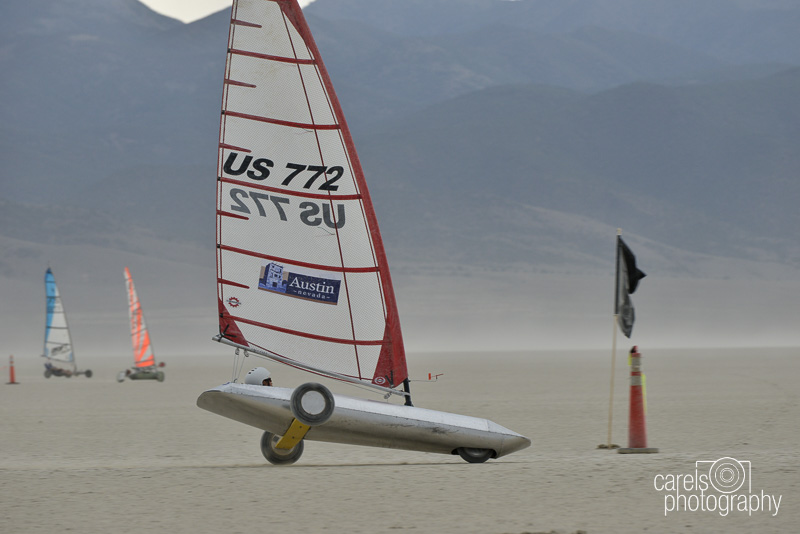Down in Nevada in the second week of July, on the arid surface of a high-altitude playa, sailors from all over the world waited on the wind and raced across the desert, with no water in sight.
Roughly 200 competitors from 15 countries and about 100 spectators gathered on the Smith Creek Playa, elevation 6,000 feet, where the FISLY-NALSA 14th Landsailing World Championships took place from July 12-19. (FISLY-NALSA stands for the International Land and Sandyachting Federation and North American Land Sailing Association.)
John Eisenlohr, 51, of Lakeside, was one such competitor, and now holds the title of world champion in the 5.6 mini class, during which he piloted a self-made land yacht that, according to the rules, must fit in a 5.6-meter continuous loop of rope.
The fuselage is attached to a sail and sits on top of wheels, and the pilots must steer the contraption through a course. Crashes are spectacular and common, Eisenlohr said.
Sailing is part of Eisenlohr’s heritage, with weekend jaunts to the Southern California deserts for landsailing when he was a kid and his father, Bill Eisenlohr, being a celebrated boat builder.
In fact, there’s hardly any surface that Eisenlohr can’t or won’t sail. In the winter, he trades the wheels on his land yacht for ice runners, and he glides across the frozen landscape in Northwest Montana.
Last winter was a particularly good one for him, Eisenlohr said, because it got below zero multiple times, allowing for hard, fast ice.
“I haven’t sailed on Flathead Lake on ice for years, and I got tons of time on the ice because the winter was good,” he said. “I logged over 300 miles on the ice.”
Since his business, Lakeside Cabinetry, allows for the space and tools needed to build his vessels, Eisenlohr spends the time fine-tuning his boats. The mini he raced in his award-winning competition was the same he used on the ice over the winter, and he learned its quirks enough to sail it effectively.
“I got to know it very well, and got really comfortable in it,” he said.
That’s important in the relatively new mini class, because they can get a little “squirrelly” in the wind due to their size. There are few rules about how to build a craft, and Eisenlohr designed his with an enclosed fuselage, instead of the traditional open design.
“I figured I’d go the aerodynamic route and that seemed to have worked,” he said.
He’s been racing as a landsailor since 1985, and even fell in with a likeminded crowd when he moved to Montana in 1995. It’s not uncommon to see sailors taking on the ice at Canyon Ferry Lake near Helena in the winter, he said, or at Freezeout Lake.
Eisenlohr also races with his nephew, Will Eisenlohr, who placed third for the U.S. in his class and helped the U.S. earn a silver medal.
Before July’s competition, the best Eisenlohr had placed in an international event was sixth, and that was with a different class of boat. With his world-champion status, Eisenlohr received a few medals and the opportunity to call himself the champ for the next four years.
It wasn’t an easy victory, with the wind playing hide and seek for a few of the racing days; even at 6,000 feet, the temperature still hovered in the 90s, Eisenlohr said, so waiting for the wind became a hot and dehydrating experience.
Of the 40 sailors in his class, there were some who were faster, he said, but none exhibited the consistency in their heats. He continually placed in his races, with fifth place being his worst, and eventually topped the second place finisher by five points.
Despite the rough conditions, Eisenlohr said he had a wonderful time at the competition, and enjoyed watching his nephew compete.
And did he enjoy winning a world title after nearly 30 years of competing?
“Oh heck yeah, I’m thrilled,” Eisenlohr said. “It’s great.”
